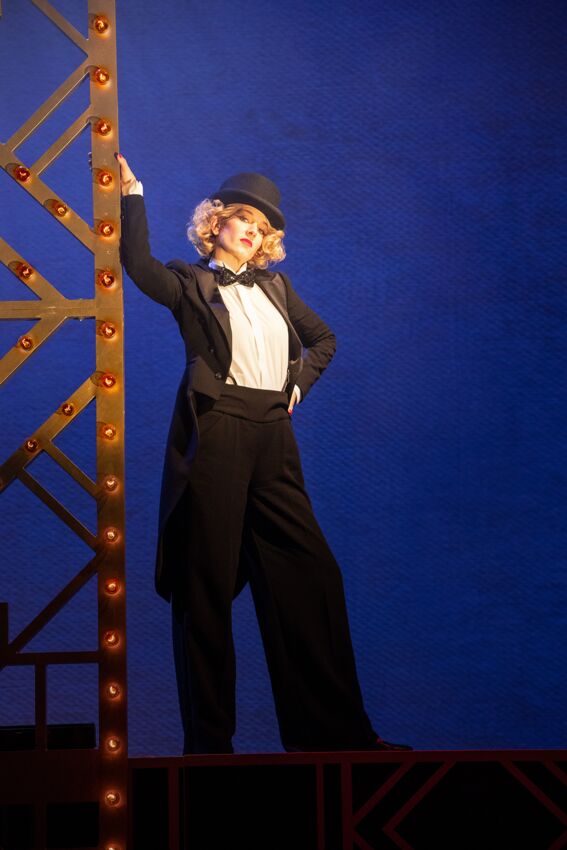BACKGROUND
Berlin – a city of the roaring twenties
Berlin
The Berlin of the 1920s is a pulsating metropolis. A city that never sleeps and a hotspot of the Roaring Twenties. At the same time, Berlin is full of contradictions: Glamour, luxury and an exuberant lust for life rub up against poverty, unemployment, hunger and slum conditions in the tenements. A respectable but unremarkable town for most of the nineteenth century, it suddenly expands at breakneck speed to become the third-largest city in the world with 3.9 million inhabitants. They now need to be entertained. After the miseries of the First World War, Berlin’s wild nightlife with its 40 theatres and more than 170 variety venues promises distraction and debauchery. The largest entertainment palaces – such as the Admiralspalast, the Haus Vaterland with its 8000 seats, or the famous Winter Garden – light up the night skies. They host the era’s greatest stars, including the Comedian Harmonists and Josephine Baker. Countless other bars, drinking holes, ballrooms, cafes and nightclubs offer the opportunity to dance the night away and lose yourself in a blur of hedonism. No matter what gender or sexual orientation, Berlin caters to everyone. There are more gay, lesbian and transvestite bars than anywhere else in Europe. The possibilities for thrilling entertainment are endless. Welcome to the most exciting city on earth!
Roaring Twenties
The Roaring Twenties must be the most thrilling decade of the twentieth century. A century later, people around the globe are still fascinated. In fashion, music, entertainment, art, culture, technology and society, the 1920s are an explosion of modernity and dynamism. People flock to cities like Berlin, attracted by a new sense of freedom: By day you can drive your new automobile along the AVUS-Autobahn in Berlin, telephone your friends to arrange a get-together in the evening, listen to the first wireless programmes or play the latest record on the gramophone. By night you can dance to the intoxicating sounds of Swing and Charleston. Jazz is spilling over to Europe from the USA: In 1926 the first Duke Ellington musical is performed at the Admiralspalast in Berlin; the nation is gripped by Charleston fever. Fashionable drinks such as Absinthe and other substances help to lower inhibitions. Chorus girls and nude dancers bare all. Everything is possible in the big city: Love embraces freedom, same-sex relationships are lived openly, gender is fluid. Transvestite bars such as the famous El Dorado in Berlin become nightlife meccas. Fashions, too, are an expression of new freedoms: bobbed hair, knee-length dresses and even trousers are all the rage for women. Men on the streets wear suits or sportive knickerbocker trousers with braces – and, of course, always a cap or hat. Artists such as Otto Dix immortalise the restlessness of the time in their fantastical paintings, depicting a decade that continues to inspire people to this day.
The stock market crash of 1929, followed by the Great Depression and eventual rise of the Nazis, puts an end to this glittering era.
Admiralspalast Berlin
Cinema, skating rink, public indoor swimming pool, glittering variety venue: The Admiralspalast in Berlin had many identities, but in the 1920s it lit up the wild nights as one of the most spectacular of all of Berlin’s entertainment venues. From 1923 onwards the palatial theatre on the Friedrichstraße was the home of the “Variety Admiral” Herman Haller and his dazzling variety shows. Extravagant decorations, innovative stage technology, plenty of titillation and racy dance ensembles such as the long-legged Tiller Girls attracted a mass audience. Tourists, intellectuals, clerks, shop girls and street kids – in short, the whole world – danced the nights away in the theatre’s foyers, bars and cafes.
The 1929 crash marked the end of a golden era. Operettas became more popular and began to replace the variety shows. After the war, the Admiralspalast was used as an alternative venue for the Berlin State Opera and other state theatres. It re-opened after the fall of the Berlin Wall and has been building on its 1920s glory days since 2011.
Legends of the Golden twenties

Comedian Harmonists
Six extraordinary singers and talented performers with a treasure trove of hits – the Comedian Harmonists are the boy band of the 1920s. Even today, almost a century later, most Germans know the songs My Little Green Cactus, Veronica, Spring is Here, and Beautiful Isabel from Castile. The six singer’s journey from obscurity to superstardom in the Weimar Republic sounds like something straight out of a film script: Failed actor Harry Frommermann places an ad in a newspaper looking for singers to start a band. The opera singer Robert Biberti responds and brings along two of his opera chorus colleagues, Ari Leschnikoff from Bulgaria and Roman Cycowski from Poland. Later they are joined by singer Erich Collin and pianist Erwin Bootz. Within a year and following an audition with the king of cabaret Erik Charell, the sextet is on the road to success. They become the stars of the gramophone era, recording hit after hit, starring in films and their own shows, touring all over Europe and staying in the best hotels. They have the world – and women – at their feet.
With the rise of the Nazis, the fairy tale comes to a sudden end. By 1934, new laws make it impossible for the three Jewish members of the ensemble to perform in public. Two new, separate, ensembles (calling themselves the Meistersextett on the one hand and the Comedy Harmonists on the other) fail to build on their previous success.
Marlene Dietrich
Famous legs, distinctive voice, suit and hat, German legend, style icon, Hollywood star, Blue Angel, Lilli Marlen, chanteuse, unforgotten diva – who else can it be but Marlene Dietrich?
Her career starts with a bang: In 1930 she lands her breakthrough role of Lola Lola, the beautiful but frivolous cabaret singer in a top hat and suspenders who causes the downfall of the respectable Professor Immanuel Rath. Almost overnight, she is famous. And she can sing! Provocative and aggressive in “They Call Me Naughty Lola”, seductive and smoky in “Falling in Love Again (Can’t Help It)”.
Abandoning her initial plans to become a violinist, she instead turned to the stage, studying acting at the renowned Max-Reinhardt-Seminar. Small roles on stage and screen followed. The advent of sound film was a great opportunity for her and the success of The Blue Angel enabled her to make the move to Hollywood, where she soon became a star. Styling herself as a new type of sex symbol, she pioneered an androgynous look: seductive, but cool. After the Second World War she embarked on a new career as a singer, famous for her deep, sultry voice.
Josephine Baker
Her short hair slicked back, a mere hint of feathers around her hips, a few strings of pearls around her neck – Josephine Baker’s first appearance in Berlin in 1926 is a sensation. She pulls faces, walks on all fours and shimmies across the stage. Berlin instantly falls under her spell. Josephine Baker is one of the most remarkable and famous women of the era. The nude dancer with the iconic banana skirt costume takes her life into her own hands in a way that few women are able to do at the time. Born in St. Louis in 1906 to an African-American mother and a Spanish father, she joins the theatre as a teenager to escape the poverty of her childhood. Her journey takes her to Paris, where she performs in grand theatres such as the Théâtre des Champs-Elysées and soon becomes a star. Europe is gripped by Charleston fever. When she dances, Josephine Baker defies all conventions, flaunting her hips, rolling her eyes and folding her body into acrobatic contortions. Her performances in Berlin are the stuff of legend and seal her status as a 1920s icon.
Anita Berber
Her pale face is dominated by plucked brows and lips like a gash of red blood. Sometimes she wears men’s tuxedos, sometimes fur coats with a small pet monkey tucked into her cleavage. She drinks a bottle of cognac before each performance: Anita Berber is the Weimar Republic’s most notorious femme fatale.
Born in 1899 as the daughter of a cabaret artist and a musician, she starts dancing in Berlin’s nightclubs in 1917. On stage she wears very little or nothing at all, performing pieces such as the aptly named Dances of Vice, Horror, and Ecstasy. Scandal is her constant companion. As an artist, Anita Berber breaks taboos and pioneers new androgynous fashions (including for women to wear tuxedos). Her behaviour – fuelled by serious drug and alcohol addictions – is considered extreme even by the standards of Berlin’s wild nightlife. With her strong, beautiful features and expressive face she is destined for silent cinema, starring in numerous productions. She dies 1928 in Berlin, at the age of only 28.
Dances of the twenties
Charleston
The Charleston is the most fashionable dance of the 1920s. Dancers everywhere kick out their legs and swing their arms, abandoning the strict rules of traditional social dances such as the waltz or foxtrot. Named after the American city where it was invented, the Charleston arrives in Europe at the same time as Jazz music, causing an immediate sensation. No longer are dancers required to glide serenely across the floor: Feet and legs can fly in the wildest directions, with arms and hips being flung out to balance off-key positions. What is more, the Charleston can be danced in mixed or same-sex couples (men with women, women with women or men with men) as well as alone. Josephine Baker’s legendary performances are instrumental in popularising the dance in Europe, and the first Charleston on film is performed by Bessie Love in the 1925 romantic comedy King on Main Street.
Lindy Hop
Can you dance socially in a couple and still go wild? Yes, with Lindy Hop you can! No longer restricted by a formal dance hold, it offers both freedom and real connection with a partner. Dancing Lindy Hop, everything is possible – even spectacular lifts and acrobatic tricks. The liberating dance was invented in the late 1920s and made famous by the legendary Savoy Ballroom in Harlem. By the 1930s, the whole of America had succumbed to Lindy Hop fever. People danced in ballrooms, on stage and in films, accompanied by the rousing sounds of the big bands. Popular to this day, Lindy Hop is the father of other dances such as the Jive, Boogie-Woogie and Rock ‘n’ Roll.

